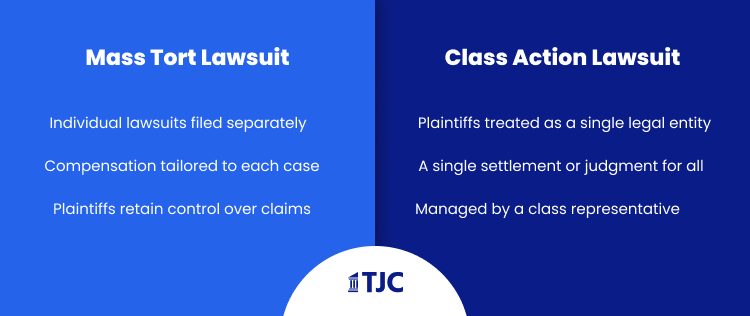Mass tort litigation helps everyday people fight powerful companies when something goes wrong — like a harmful product, a toxic spill, or a defective drug. These cases let individuals join forces, share resources, and fight for justice while still keeping their personal claims unique. We’ll explain how mass torts work, why they differ from other lawsuits, types of cases, and more!
What Is a Mass Tort?

A mass tort refers to a type of civil procedure in which multiple plaintiffs file lawsuits against the same defendant(s) for similar injuries. These cases typically arise from a single product, event, or action that causes harm to many individuals.
Characteristics:
- Individualized Claims: Unlike a class action lawsuit, plaintiffs in mass tort actions file their own claims, allowing for tailored compensation based on unique circumstances.
- Large Group: While each plaintiff retains their case, these lawsuits involve a significant number of individuals with common issues.
- Similar Injuries: The injuries alleged by plaintiffs stem from the same source — be it a defective drug, environmental contamination, or faulty product.
Notable sample:
The Camp Lejeune water contamination case, which exposed military families to toxic chemicals for decades, exemplifies the scope of mass tort lawsuits. With over 500,000 potential claimants, this case underscores the importance of mass torts in addressing widespread harm.
Differences Between Mass Torts and Class Actions
Although mass torts and class action lawsuits share similarities, their differences are crucial in understanding how the legal system categorizes large-scale cases.
In multi district litigation (MDL), often used in mass tort claims, pretrial proceedings for thousands of cases are consolidated. 52% of federal civil cases were handled via MDL, demonstrating its efficiency for mass torts. In comparison, class action lawsuits play a smaller role in consolidated cases. They are more specifically applied to situations where plaintiffs share nearly identical claims and damages.
Types of Cases Involving Mass Torts
Mass torts cover a range of legal issues, but they typically fall into these categories:
- Product Liability: Defective products that cause injuries, such as Roundup, which has been linked to cancer. This case has led to over 50,000 claims and settlements exceeding $10 billion.
- Environmental Hazards: Toxic contamination cases involve harm caused by pollutants (such as PFAS, Asbestos, Paraquat and AFFF cases). These cases often take decades to uncover but can result in significant compensation for affected groups.
- Pharmaceutical Injuries: Prescription drugs with unforeseen side effects, such as Vioxx, which was linked to heart attacks and strokes, resulted in a $5 billion settlement after extensive litigation.
- Defective Medical Devices: Faulty medical implants, like hernia mesh, have spurred thousands of lawsuits alleging complications that required corrective surgeries and caused long-term harm.
- Emerging trends: Recent mass tort actions include lawsuits over hair relaxers linked to cancer and the diabetes medication Ozempic, which has raised safety concerns.
How Does the Mass Tort Process Work?
The legal process for mass torts is intricate, involving several coordinated steps to ensure justice for plaintiffs while streamlining the judicial process.
- Identifying Affected Individuals: attorneys investigate and identify individuals harmed by a common source, such as a defective product or toxic exposure. Public notices and outreach often play a critical role in this phase.
- Filing Individual Claims: each plaintiff files a separate lawsuit outlining their specific injuries and damages. Unlike class actions, these lawsuits retain individuality even when consolidated.
- Consolidation for Pretrial Proceedings: under federal rules, mass tort cases often move to multi-district litigation (MDL) to efficiently manage discovery, expert testimony, and pretrial motions. This step ensures consistency across cases while addressing shared legal questions.
- Resolution Through Settlement or Trial: once pretrial proceedings are complete, individual cases proceed to trial or settlement negotiations. Compensation varies based on factors like the severity of injuries and the strength of evidence.
Pros and Cons of Mass Torts
Pros?
- Access to Justice: Mass tort lawsuits empower individuals to seek justice against large corporations without bearing the financial burden alone.
- Efficient Legal Process: Consolidating cases reduces duplication of efforts, especially during discovery and expert testimony phases.
- Potential for Higher Settlements: Plaintiffs may receive larger payouts compared to class actions, as damages are calculated individually.
Cons:
- Complexity: Coordinating thousands of plaintiffs and managing evidence across jurisdictions can make these cases extremely challenging.
- Lengthy Timelines: The average mass tort case takes 3–5 years to resolve, with some stretching even longer.
- Unequal Settlements: Plaintiffs with less severe injuries may receive lower compensation compared to others in the same lawsuit.
Famous Mass Tort Cases
Below are five pivotal examples, each representing a different type of mass tort.
1. Asbestos Cases
Since the 1970s, asbestos litigation has involved over 700,000 claimants and settlements exceeding $70 billion. Plaintiffs suffered diseases like mesothelioma after exposure to the material. Lawsuits prompted bans and safer industry standards.
2. Tobacco Litigation
The 1998 Master Settlement Agreement resulted in a historic $246 billion payout from tobacco companies to 46 states. This landmark case addressed deceptive marketing practices and public health costs linked to smoking. States used funds for anti-smoking campaigns and healthcare improvements.
3. AFFF Lawsuits
Firefighting foam, known as AFFF, contains toxic PFAS chemicals linked to cancer and groundwater contamination. Over 5,000 lawsuits have been consolidated into multi-district litigation, with settlements potentially reaching billions.
4. PFAS Lawsuits
Per- and polyfluoroalkyl substances (PFAS), used in household products, have polluted drinking water for millions. Studies link PFAS exposure to cancer and immune disorders. Recent settlements include $1.19 billion from 3M, addressing contamination claims.
5. Paraquat Litigation
Paraquat, a widely used herbicide, has been linked to Parkinson’s disease and other neurological disorders. Over 2,000 lawsuits allege manufacturers failed to warn users of the risks. Settlements are expected to exceed $1 billion.
How to Know If You Have a Mass Tort Claim
Determining whether you qualify for a mass tort action involves several steps:
- Consult an Attorney: Legal counsel can evaluate your case and determine whether it aligns with a mass tort lawsuit.
- Gather Evidence: Compile medical records, receipts, and documentation of exposure to harmful products or events.
- Verify Eligibility: Your case should involve similar injuries as others in the potential mass tort and demonstrate a clear connection to the defendant’s product or action.
Challenges in Mass Tort Litigation
One major obstacle is proving causation. Establishing a direct link between the defendant’s actions and the plaintiff’s injuries. This can be especially difficult when not all individuals exhibit the same injuries, making expert testimony and scientific evidence essential.
Another challenge is coordinating large groups of plaintiffs. Managing thousands of individual cases fairly demands significant legal resources and expertise to ensure that each claim is addressed appropriately.
Mass tort cases often have lengthy timelines, sometimes taking years to resolve, which can test the patience and financial stability of the plaintiffs involved.
Mass Torts FAQs
How Long Does a Mass Tort Case Take?
Most mass tort cases take 3 to 5 years to resolve. Timelines vary based on factors like the complexity of the case, the number of plaintiffs, and how quickly evidence is gathered. Some cases settle sooner if negotiations progress smoothly.
Delays can occur due to court schedules, the need for expert testimony, or disputes over liability. Each case is unique, so the timeline may differ. It’s important to have patience, as these steps are essential to ensure fair compensation for all plaintiffs.
Can Anyone Join a Mass Tort Case?
Not everyone qualifies to join a mass tort case. Eligibility depends on proving you were harmed by the product, event, or action in question. Plaintiffs must show a connection between the harm suffered and the defendant’s alleged wrongdoing.
Evidence like medical records or proof of exposure is often required. Timing is also critical, as claims must usually be filed within a specific statute of limitations. Consulting a lawyer early can help determine if you meet the requirements.
What Compensation Can Be Expected?
Medical expenses are a common form of compensation, covering treatments, medications, and ongoing care. Lost wages are also included if the injury affected the plaintiff’s ability to work. Pain and suffering damages may address physical discomfort, emotional distress, and reduced quality of life.
In some cases, courts award punitive damages. These are meant to punish the defendant for reckless or harmful behavior. Compensation is calculated individually, even in cases involving many plaintiffs. The amount depends on the severity of the injury, evidence provided, and its long-term impact on the plaintiff’s life.
What Is the Difference Between MDL and Mass Tort?
MDL (Multidistrict Litigation) consolidates multiple similar cases for pretrial proceedings. This process saves time, avoids duplicate efforts, and ensures consistency in rulings. After pretrial, cases can return to their original courts for trial if unresolved.
A mass tort is the broader legal approach to handling many lawsuits tied to the same issue. MDL is one way to manage mass torts efficiently, but not all mass torts involve MDL. Each plaintiff in a mass tort retains their own case and potential outcome.
Conclusion
Mass tort law is a unique and powerful legal avenue for individuals who have suffered harm from defective products, medical devices, or drugs. Unlike traditional personal injury cases, mass torts allow for collective action while still focusing on the individual experiences of each plaintiff.
Mass torts often utilize multidistrict litigation (MDL) to streamline legal processes. MDL consolidates cases with common issues before one court, which reduces duplication and ensures consistency in rulings.
Mass tort lawsuits play a vital role in addressing widespread harm, giving everyday people a chance to stand up against powerful corporations. They bring efficiency to the legal process while ensuring each person’s unique story and damages are heard.
If you’ve been affected by a defective product, toxic exposure, or corporate negligence, don’t wait—talk to a trusted attorney today to understand your options and protect your rights.
Disclaimer: The information provided in this article is for informational purposes only and does not constitute legal advice. Readers should consult with a licensed attorney for legal guidance regarding their specific situation. The content is not intended to create, and receipt of it does not constitute an attorney-client relationship.



